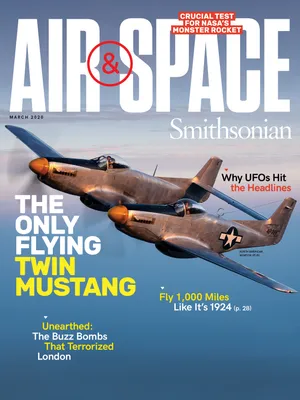This Former Storm Chaser Helps Airline Pilots Avoid Turbulence
An interview with Mike Eilts, senior vice president at DTN.
:focal(999x373:1000x374)/https://tf-cmsv2-smithsonianmag-media.s3.amazonaws.com/filer/cc/4b/cc4b302c-1645-4153-bbc9-1b6b0b8b88ee/33a_fm2020_mikeeilts_live.jpg)
Atmospheric turbulence costs the global airline industry nearly a billion dollars a year in damage to aircraft, injuries to passengers and crew, and emergency landings. As digital weather forecasting continues to improve, these same types of algorithms are being used to forecast turbulence. Mike Eilts, a senior vice president at DTN, spoke about the emerging industry with Air & Space senior associate editor Diane Tedeschi last December.
Air & Space: What is clear air turbulence?
Eilts: When we talk about clear air turbulence—so called because pilots can’t see it—airplanes are typically at 30,000 to 35,000 feet, and the turbulence at that altitude is caused by weather patterns colliding with each other. Wind shear at that level also causes turbulence to form.
Is clear air turbulence the most threatening type for commercial airliners?
Yeah, it’s most dangerous because you can’t see it. There is as strong—or stronger—turbulence around thunderstorms, but there are restrictions on how close you can fly to severe storms.
What service does your company offer the airlines?
A given airline will upload, say, all of their planned trips for tomorrow, and we’ll tell them which ones have potential turbulence along that route—typically long routes between continents. If we say, hey, there’s strong or extreme turbulence along that route, they’ll send us back three or four other routes and ask, “Is this route better?” And we’ll provide them the safest route that uses the least amount of energy. So we’re helping them cut fuel costs but still stay safe. We support about 12,000 flights a day with that kind of service.
Is the information your company provides based on a computer model?
Yeah, we built a proprietary algorithm working with former employees of the Aviation Weather Center—people who have expertise in predicting clear air turbulence. Our algorithm predicts where turbulence is going to be and at what altitude so pilots can vector around it. We help them map where it is.
Is climate change having an impact on the routes airliners fly?
That’s a great question. I would say probably not much—if any. People are speculating that there might be more clear air turbulence because of climate change. Because if you have stronger weather systems, you might get more turbulence in the interfaces between those systems. But as far as airlines changing their everyday routes because of climate change, I don’t think that is happening—yet.
Tell me about your work as a storm chaser.
Back in the day, part of my job at the National Severe Storms Laboratory was to get out and document tornadoes and hail and compare it to what we saw on radar to help the National Weather Service issue warnings. Storm chasing has two sides: One is pure research. The other is just going out and seeing an awesome thing in nature that has a lot of power and a lot of beauty.
